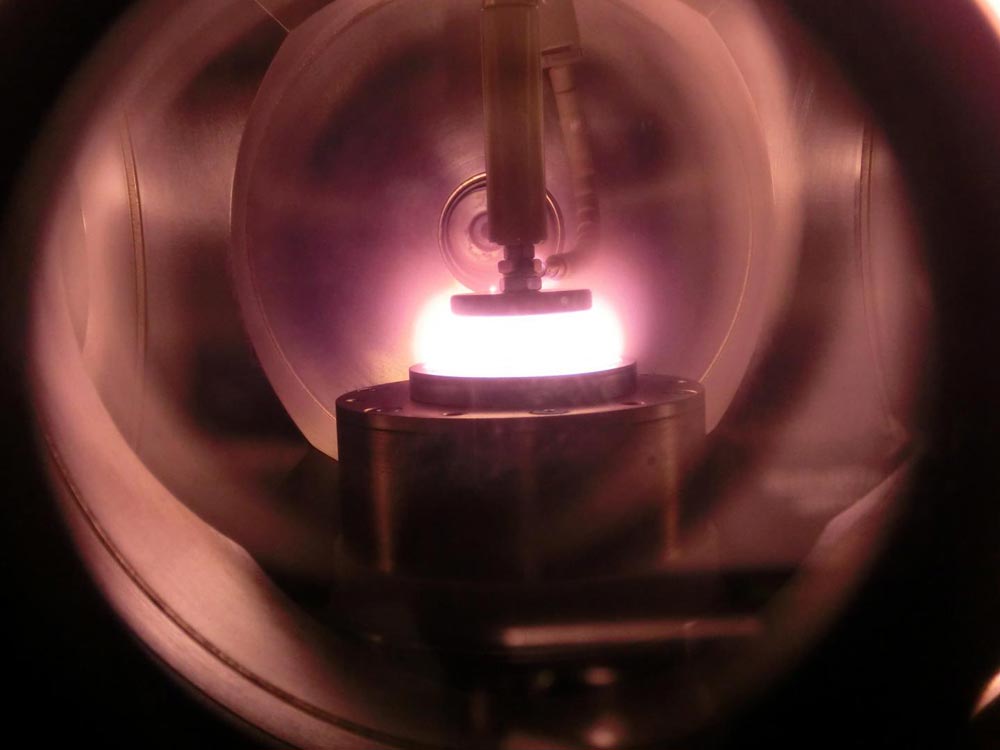

Plasma glows white in low-pressure helium between magnetized cathode electrode, bottom, and anode electrode, top.
Credit: General Electric
GE is testing a tube filled with plasma — the charged state of matter composed of free electrons and ions that PPPL studies to understand fusion energy and a wide range of processes — that the company is developing as the conversion device.
The switch must be able to operate for years with voltage as high as 300 kilovolts to enable a single unit to cost-effectively replace the assemblies of power semiconductor switches now required to convert between DC and AC power along transmission lines.
PPPL models switch
Since testing a high-voltage plasma switch is slow and expensive, GE has turned to PPPL to model the switch to demonstrate how the high current affects the helium gas that the company is using inside the tube. The simulation modeled the breakdown — or ionization — of the gas, producing fresh insight into the physics of the process, which scientists reported in a paper accepted in the journal Plasma Sources Science and Technology.
The results built upon a 2017 PPPL paper published in the journal Physics of Plasmas that modeled the effect of high-voltage breakdown without presenting an analytical theory.
Previous research has long studied the lower-voltage breakdown of gases. But “GE is dealing with much higher voltage,” said Igor Kaganovich, deputy head of the PPPL Theory Department and PPPL's Low Temperature Plasma Laboratory and a coauthor of the two papers. “The low-pressure and high-voltage breakdown mechanism has been poorly understood because of the need to consider new mechanisms of gas ionization at high voltages, which is what we did.”
The findings identified three different breakdown regimes that become important when high voltage is used to turn helium into plasma. In these regimes, electrons, ions and fast neutral atoms start the breakdown by back-scattering — or bouncing off — the electrodes through which the current flows. These results contrast strongly with most previous models, which consider only the impact of electrons on the ionization process.
Findings useful for GE
The findings proved useful for GE. “The potential applications of the gas switch depend on its maximum possible voltage,” said GE physicist Timothy Sommerer, who heads the project. “We have already experimentally demonstrated that a gas switch can operate at 100 kilovolts and we are now working to test at 300 kilovolts. The results from the PPPL model are both scientifically interesting and favorable for high-voltage gas switch design.”
###
Lead author of the papers was Liang Xu, a visiting Chinese graduate student whom Kaganovich advised and is now a physicist at Ruhr-University in Bochum, Germany. Co-authors of the papers included GE's Sommerer and physicist Alexander Khrabrov of PPPL. Support for the PPPL research comes from the DOE's Advanced Research Projects Agency-Energy through GE, and from the DOE Office of Science.
PPPL, on Princeton University's Forrestal Campus in Plainsboro, N.J., is devoted to creating new knowledge about the physics of plasmas — ultra-hot, charged gases — and to developing practical solutions for the creation of fusion energy. The Laboratory is managed by the University for the U.S. Department of Energy's Office of Science, which is the largest single supporter of basic research in the physical sciences in the United States, and is working to address some of the most pressing challenges of our time. For more information, please visit science.energy.gov.












